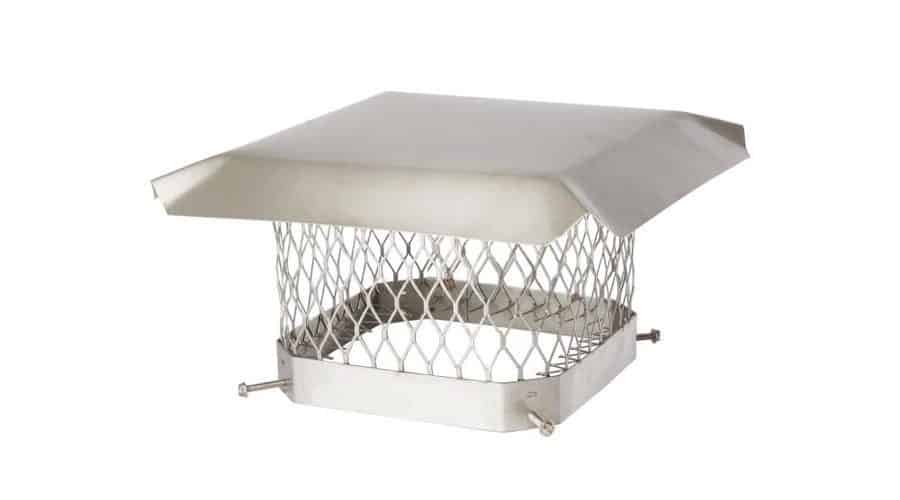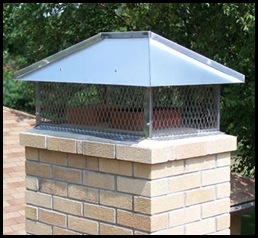Chimney Cap
<>
Chimney caps began appearing atop residential chimneys for the past two decades. Industrial sites have always been required to contain fly ash with chimney caps. Homes with central heating and fireplace chimneys took a cue from industrial chimney rain caps in this respect. Stainless chimney caps have a secondary and more important use for residential chimneys. Steel chimney caps protect the interior chamber of the flue from debris that can accumulate and create an unnecessary clean-up job. Leaves, insects and even a stray bird or two can sometimes gravitate toward a chimney that hasn’t had a fireplace chimney cap installed. There is another important consideration for installing a chimney cap and that is that it helps protect the chimney from inclement weather. Without a metal chimney cap, wind shifts during rain and snow storms can bring about a small amount of leakage. The round chimney cap provides protection from this.
Contents
Chimney Caps – Size and Style
Today’s custom chimney caps are built to last. Most galvanized chimney caps are no larger than twelve to fifteen inches in diameter. The size of the opening at the top of the chimney determines the specific size needed. The decorative chimney cap is built as a mesh cage that traps fly ash from fireplace fuels like wood or coal. The mesh cage has a metal flange or shade finishing at the top. It’s similar to a “cap” that is slightly larger than the mesh cage beneath it. The flange sits over the top of the mesh cage neatly and is built with a small mesh screen that allows smoke or other emissions to escape while containing any particulate from the fireplace chamber and preventing debris from entering inside. The styles can be fairly utilitarian to those that are designed in various models.
The chimney caps are made from aluminum mesh and the flanges may be either aluminum or galvanized steel in strengths that are resilient to high heat. It’s important to ask the installer what materials are used for the chimney caps they have available. Without high quality materials, the cheap chimney caps may not be as durable.
Installation of Chimney Caps
Professional installation of chimney caps includes proper sizing, adjustments to fit the opening of the chimney on the roof, sealing the base of the chimney cap to the chimney with cement adhesive and flashing to keep the chimney cap secure and prevent leaks that occur with aging. The entire process of installing concrete chimney caps takes less than a couple of hours. The cost of chimney caps is relatively inexpensive considering the security it provides. Fireplace useage is safer and there is less worry about debris accumulating. Depending upon the size and type selected, a large chimney cap can cost less than one hundred dollars. This doesn’t include the cost of installation labor.
How To Choose A Chimney Cap Installer
Most any professional chimney expert who inspects chimneys can provide detailed information on the installation of a brick chimney cap for the central heating chimney and the fireplace chimney. When you contact an installer, be sure to let them know you are interested in having rotating chimney caps installed. The chimney expert will walk the customer through the necessary information on installation, costs and time involved. It’s also expedient to check whether a warranty for the equipment is available should a defect in material quality occur. Chimney cap installation services are available online as well as locally. Look for installers with experience. Also check with the installer prior to the installation as to whether the work is insured. Whenever any service group is engaged to perform work on a residence, there should be some type of liability insurance to perform the service according to safety compliance standards.
Do You Need A Chimney Cap?
If you have a fireplace or central heating chimney that receives regular use, a chimney cap should be the finishing touch to initial installation. Installing the discount chimney cap at the same time as the fireplace or central heating chimney is installed on a new home saves time and money. The great thing about these chimney caps is that they can be installed at any time without serious interruption of chimney use. Although, the installer may delay installation if weather is inclement. The reason for this is that the cement adhesive and flashing will not settle and dry properly. This is a standard practice with any masonry that is done with cement adhesives. The best time of year to consider installing a chimney cap is during the summer season through the late fall. This is generally when the weather cooperates with installers most. In addition to the convenience a chimney cap provides, there is also the value they add to a home. There is no maintenance required by the homeowner other than having the annual inspection of the chimney.
Related Posts
- How To Light A Gas Fireplace?
- Chimney Brushes
- How To Install A Wood Burning Fireplace?
- How To Install A Fireplace Insert?




